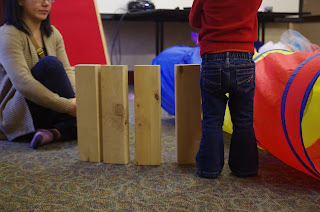One of the trickiest parts to figure out in Anji Play is finding comfort in stepping back and still being present. Here are two (true!) stories to illustrate the opposite ends of the spectrum (names and specifics have been removed to protect privacy -- the photos below are unrelated to the incidents described and are simply included for those of us who have an easier time reading blocks of text that are broken up by photos!):
(note: right after this photo was taken, this child was scooped up and comforted by his caregiver!)
Scenario A:
A caregiver brings a young child to an Anji Play program. The adult is given the "hands down/mouth closed/eyes open/ears open/heart open" instructions and when, after she sets the child down to play, he begins to cry loudly, she decides that since the instructions have said "hands down/mouth closed" that she should not pick up the child or interact with him in any way. He continues to feel quite distressed, but she adheres to an understanding that these are the parameters of the program and doesn't respond to him.
A caregiver brings a child to an Anji Play program. Her child is building a tall tower of blocks with a group of children, one of whom is a young, somewhat unstable toddler. The caregiver is concerned about the safety of the toddler when the tower gets so tall that it becomes wobbly, so she instructs her child to split the tower in half and build two shorter towers instead.
(note: this child had actually chosen to line up her blocks like this herself)
In both of these scenarios, the adult responded based on their understanding of the practice of Anji Play, but in both instances practice got in the way of principle. In Anji Play, the very first and most important principle is Love. In scenario A, we might assume that the child was not feeling the safety net of love in that moment. Because there was no assurance of love and safety, that child did not feel comfortable taking any risks at all (including the social/emotional risk of venturing out to try playing). Sometimes we misunderstand “stepping back” as cold distance, but it’s really about communicating trust (in the child’s capabilities) and love. Before all else, children must feel safe and loved before they can feel free to choose their own play.
In scenario B, teachers in Anji County might choose, instead, to stand nearer the toddler, ready to protect them should the blocks fall their direction. The wonderful thing about that moment when the block tower is so tall that it becomes unsteady is precisely the unpredictability of it. When will it topple? Which direction will it fall? What will it sound like? Can I build it even taller next time? If we, as caregivers, step in at exactly that point, the child will not discover the answers to these questions and the flow of play is interrupted, broken. While it is always important for us to keep children safe, are there ways that we can keep them safe while not cutting off their opportunities to learn at the same time?
Please note: "Anji Play,” refers to a specific philosophy and comprehensive approach to early education developed by Ms. Cheng Xueqin in Anji County, China. I use the term "Anji Play" to describe my programming and throughout this blog with the explicit permission of Ms. Cheng because our programming has been developed as part of a close collaborative relationship with her and her team of Anji Play educators. If you are interested in learning more about how you can bring Anji Play to your community, please visit www.anjiplay.com





No comments:
Post a Comment